Signs It's Time To Remove A Tree - A House Owner'S Guide
Signs It's Time To Remove A Tree - A House Owner'S Guide
Blog Article
Personnel Author-Churchill Bendixen
Trees include elegance and worth to residential or commercial property, but they can also pose a threat during extreme weather condition occasions. If a tree has actually quit growing, is exhibiting visible fungal growth, or has a leaning trunk, it should be gotten rid of by a professional to prevent home damages and injury.
For more information, attend a home owner source reasonable co-hosted by HPD, the Center for NYC Neighborhoods, and Brooklyn-based real estate partners this night in Bedford-Stuyvesant. The event will feature the Property owner Handbook, a brand-new guide to aid property owners browse the responsibilities of having a home.
1. Dead or Perishing Branches
Trees are an essential part of your home's landscape, offering color and appeal. They also give sanctuary for wild animals and create oxygen, but also healthy and balanced trees can experience health problems that might necessitate their removal. Dead or dying trees aren't simply undesirable, they can be unsafe. https://daltonjdxsl.dailyblogzz.com/29862418/picking-between-do-it-yourself-and-hiring-an-expert-for-tree-elimination can drop throughout a storm, leading to costly residential or commercial property damage and injuries.
When a tree's branches start to pass away, it implies that its framework is starting to break down. If the majority of its branches are dead, it is most likely time to remove it.
Look for an absence of new development, bark peeling, open injuries or tooth cavities, fungis expanding on the trunk or origins and a general look of degeneration in the whole cover. These indications of infection can indicate a major trouble that will require expert tree services to solve.
2. Leaning Trunk
While it's normal for trees to lean once in a while due to phototropism, if a tree has an unsafe or serious lean that's not because of natural processes - maybe a sign that the tree needs to be eliminated. If the tree is leaning toward a high-voltage line, home, car, play framework or any other location that could be unsafe to people if it falls, after that speaking to a professional tree service for removal ought to be a top priority.
It's also essential to watch for any kind of sudden changes in a tree's leaning as it can indicate damages to the roots or trunk that might cause dropping. arborist business software is particularly true during thundercloud, since high winds and rain-soaked dirt can trigger a lean to alter swiftly. Routine tracking, specifically throughout and after storms can aid homeowners identify potential troubles with their trees so they can call an arborist for a complete examination.
3. Insect Problem
Some pest infestations, such as wood-boring bugs like emerald ash borer or sap-suckers like range insects, are so severe that they can create a tree to pass away. The very best means to prevent pest problem is to monitor your trees regularly. Look for spots, openings, or stainings in the fallen leaves and bark. Examine the trunk for cracks and indications of insect damage, such as passages or tracks.
If a tree comes to be also ravaged with parasites, or is close to a home or high-voltage line, an arborist might suggest elimination. If a leaning tree develops a new, unsteady lean, an arborist will likely suggest elimination too to ensure the security of people and home. If a damaged or dead tree continually loses too much branches, it is a sign that it is time to get rid of the tree. If a tree remains to drop branches for a prolonged amount of time, it can lead to structural issues and prospective property damages.
4. Harmed Trunk
Trees are a lovely and important part of our landscape, but they do call for routine care to maintain them healthy and balanced and safe. If a tree is damaged irreparable it is likely time for it ahead down.
Seek indicators of damage to the trunk, including upright splits, joints, dead branch stubs, noticeable injuries or open cavities and extreme tree-rot. The visibility of fungi at the base of the trunk is another cautioning sign. Fungis may indicate that the phloem and xylem (life-support cells) are jeopardized, allowing for the spread of disease or a future failure.
Additionally, consider whether the tree has actually stopped expanding. Healthy trees will certainly have brand-new growth every year, which might show up as buds or branches growing and extending. If you do not see any kind of brand-new growth, it's an excellent idea to have an arborist review the tree and follow their suggestion for removal. you can check here passing away or harmed tree can drop and trigger residential or commercial property damage.